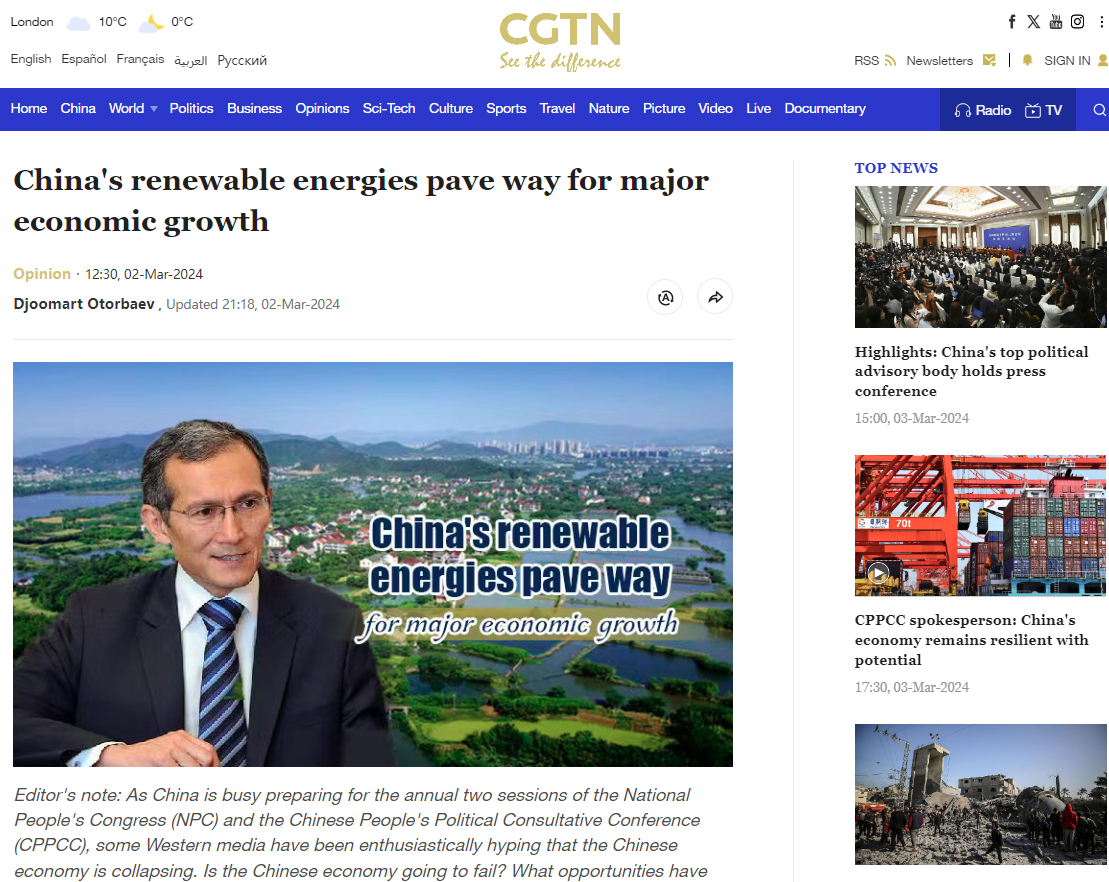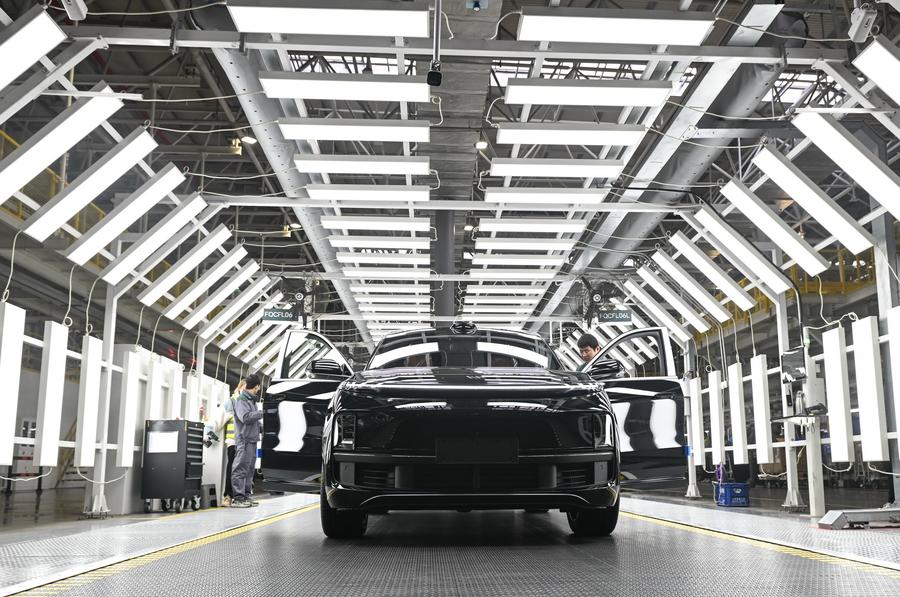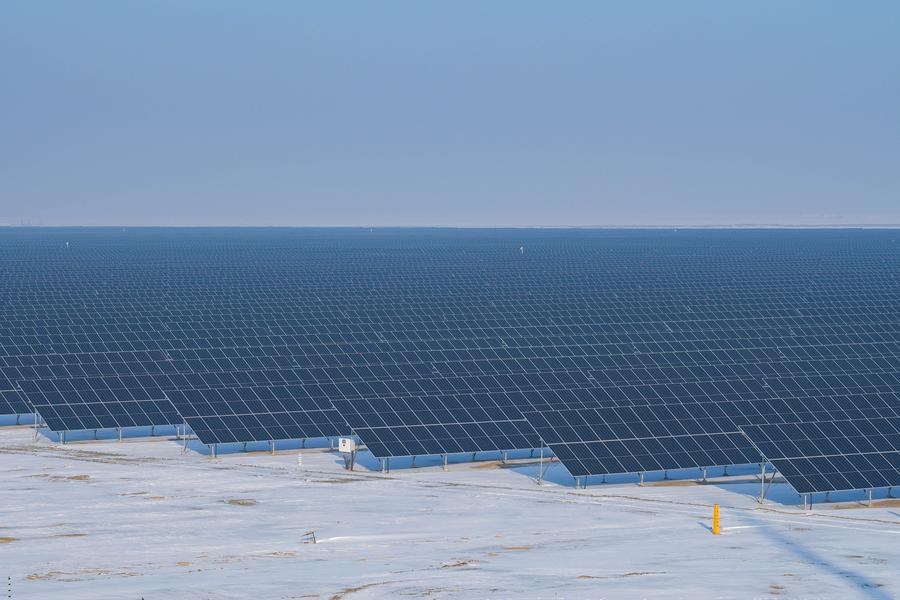LATEST INSIGHTS
Your Present Location: LATEST INSIGHTSDjoomart Otorbaev: China's renewable energies pave way for major economic growth
Source: CGTN Published: 2024-03-02

Editor's note: As China is busy preparing for the annual two sessions of the National People's Congress (NPC) and the Chinese People's Political Consultative Conference (CPPCC), some Western media have been enthusiastically hyping that the Chinese economy is collapsing. Is the Chinese economy going to fail? What opportunities have China's growth brought to the world? China’s Economy from a Global Perspective is a 10-part series analyzing the above questions. The tenth essay focuses on China's green economy. Djoomart Otorbaev is a former Prime Minister of the Kyrgyz Republic, a professor of the Belt and Road School of Beijing Normal University, a member of Nizami Ganjavi International Center, and the author of the book 'Central Asia's Economic Rebirth in the Shadow of the New Great Game'(Routledge, 2023). The article reflects the author's views and not necessarily those of CGTN.
For centuries, the importance of the harmonious coexistence between humans and the environment cannot be overstated, as it has bestowed nations with sustainable resource management and enhanced resilience to natural disasters, ultimately leading to their overall well-being and long-term prosperity.
The development of renewable energies has significant environmental and social impacts and has also shown direct and consequential economic benefits.
As a pioneer in resource conservation and environmental protection policies, China has taken significant strides in sustainable development. Being the world's largest developing nation, China is crucial in achieving the UN's Sustainable Development Goals by 2030.
Last year, clean energy accounted for 40 percent of the country's economic growth. In 2023, China's gross domestic product received a record contribution of 11.4 trillion yuan ($1.6 trillion) from the clean economy, marking a 30 percent increase from the previous year. The growth and investment were mainly driven by solar power, the production of panels, electric vehicles, and batteries.

The factory of Chinese electric vehicle (EV) maker Li Auto Inc. in Changzhou, east China's Jiangsu Province, January 10, 2024. /Xinhua
The Chinese government has consistently implemented crucial measures to facilitate smoother access to capital markets and credit for clean technology manufacturing companies. A noteworthy aspect was that private companies started joining this economic sector. This remarkable fact highlights a positive trend in transforming the national economy. By effectively managing production processes and organizing sustainable supply chains, the private sector will be able to serve both domestic and international markets much better.
The boom in clean technology investment has reinvigorated China's now famous large-scale investment model. By all accounts, this area will continue to grow steadily for many years.
In recent years, China has made significant strides in advancing clean energy technologies, investing heavily in modern technology and production. At the UN COP28 summit held in December, Beijing and more than 120 countries announced their ambitious goal of tripling its renewable energy components production capacity soon. This move is expected to bolster further efforts to develop and finance clean energy projects in the country and abroad, positively impacting humanity and the planet.

A photovoltaic power project in Kazak Autonomous County of Mori, Changji Hui Autonomous Prefecture, northwest China's Xinjiang Uygur Autonomous Region, December 20, 2023. /Xinhua
The country's development and utilization of advanced technologies in manufacturing components for clean energy have resulted in a significant and rapid drop in global prices. In a single year, the cost of solar panels decreased by an unprecedented 42 percent. Battery prices also fell a staggering 50 percent.
China is redirecting its investments towards the manufacturing of clean technology. This landmark achievement marks a new era of growth, presenting vast opportunities for investors and businesses. As the world’s second-largest economy, it is time to capitalize on its potential for generating, conserving and utilizing clean energy.
China has committed to reaching peak carbon emissions before 2030 and achieving carbon neutrality by 2060. This commitment has helped to mobilize state institutions, boost the confidence of businesses, raise public expectations, and serve as a critical policy decision for expanding and accelerating green development efforts.
It could be argued that the political, economic, environmental, and publicity factors encouraging the speedy development of clean energy intersected with a surge in demand driven by market forces, reduced costs and increased competitiveness of low-carbon technologies compared to fossil fuels.
Thanks to bold and decisive measures to recalibrate economic policies, the country has undergone a timely transition to an economic development model centered on investing in clean energy. The effectiveness of China's governance model, which prioritized long-term planning and the nation's unity in achieving crucial development goals, has again shown its efficiency.























































































 京公网安备 11010802037854号
京公网安备 11010802037854号





